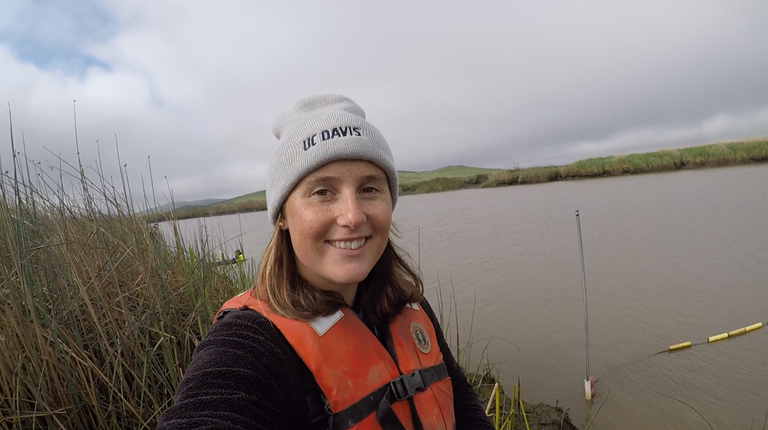Q/A: Why floodplains are important for California salmon
Photo of Hailey Wright, California Department of Water Resources environmental scientist. 
Floodplains were the historic rearing areas for juvenile salmon, and the remaining floodplains in California are an important food-rich habitat as present-day salmon grow and attempt to survive their trip out to the ocean. We sat down with Hailey Wright, a Department of Water Resources (DWR) environmental scientist, to discuss the salmon lifecycle and her work designing and implementing projects in the Yolo Bypass to improve habitat and fish passage for native salmonids and sturgeon.
Earlier this week, Hailey gave a presentation on DWR’s Water Wednesdays live educational series where she discussed juvenile salmon, their journey down the Sacramento River to the ocean, and the work DWR is doing to help salmon thrive in floodplains. You can view her talk on DWR’s YouTube Channel.
Can you explain the salmon lifecycle?
Salmon have a very interesting life cycle that has developed with the changing California landscape over the past 40 million years. There is diversity in this life cycle, but all salmon in California follow this general pattern.
Salmon hatch from their eggs in cold water tributaries throughout Northern California. They emerge from their gravel nest and live, feed, and grow for some time in fresh water before swimming downstream through the Delta, out through the San Francisco Bay, and into the ocean. Salmon spend one to four years in the ocean before retracing their steps back through the San Francisco Bay and up to the freshwater stream where they hatched.
From here, the females build nests called redds where they lay their eggs, and a male will swim over to fertilize them. The adult salmon will guard their redd until they die, allowing their carcasses to decompose and provide nutrients to the habitat their offspring will grow up in.
What stage of the salmon life cycle does your group focus on?
My group helps young salmon that are migrating out to the ocean by providing them access to the highly productive Yolo Bypass floodplain in which they feed and grow.
Our projects also assist upstream migrating adult salmon. Since adult salmon are no longer feeding at this stage, there is no benefit for them to enter the Yolo Bypass floodplain, and they simply need to continue moving upstream as quickly as possible. Our projects help upstream migrating adult salmon quickly return to the river if they enter the southern Yolo Bypass.
What are the benefits of growing up in a floodplain versus staying in a river?
Floodplains were historically common across the Sacramento Valley, so young salmon have adapted to grow up in these habitats. Floodplains are shallow, murky, slow-moving, with plenty of food and not many predators. The channelized rivers that we see today are the opposite: deep, clear, fast-moving, with not much food and many predators. Growing up in a food-rich floodplain allows juvenile salmon to grow quickly and improve survival out to the ocean.
What is your group at DWR – the Yolo Bypass Habitat Restoration Branch – specifically doing to help salmon?
My group is working on design and planning for the Yolo Bypass Salmonid Habitat Restoration and Fish Passage Project, also called the Big Notch Project. This project will increase the amount of floodplain acreage during the winter, allowing more juvenile salmon to access this productive floodplain habitat, and also provide adult fish a convenient way to return to the Sacramento River if they entered the Yolo Bypass during their upstream migration. This project involves adding a gated notch in the Fremont Weir, the northern boundary of the Yolo Bypass, providing a more constant and controlled connection of flow from the Sacramento River during the wet season. This connection will allow more juvenile salmon to enter the Bypass from the river during their downstream migration and allow more adult salmon to reenter the river from the Bypass during their upstream migration.
What is your role with DWR?
I am a fisheries biologist within an interdisciplinary team of engineers, permitting experts, managers, and project operators. I help with design and implementation of our projects to ensure that all fish-related concerns are addressed, and nothing is overlooked. I am also responsible for measuring the success of projects by carrying out fish monitoring before and after they are constructed.
What’s your favorite thing about your job?
My favorite part of my job is our annual fall-run Chinook salmon study. In this field study, we safely capture adult salmon that have entered the Yolo Bypass, attach a small transmitter to each fish, and release them back into the water so that we can track their movement until they spawn. It’s fun to catch and handle these giant fish plus the data we obtain from the study is insightful and interesting. For example, we can see which areas in the Yolo Bypass are migration barriers for adult fish, and how well our projects improve fish passage through the system.
What is your education and background?
I grew up in Davis in Yolo County and always loved science and math. I went to college at UC Davis where I studied Evolution, Ecology, and Biodiversity in the College of Biological Sciences while also playing Division I water polo. I did a research project in Panama where I studied sand dollars, and I even got to go snorkeling in the Caribbean to collect samples.
I landed my first biology job working for the Department of Fish and Wildlife (CDFW) doing fish monitoring in the San Francisco Bay and microscopy work back in the lab. After my time at CDFW, I got a job at DWR doing water quality studies and more fish monitoring. I started working in the Yolo Bypass Habitat Restoration Branch in early 2019, and I’m constantly learning more about salmon in California, and how we can help them bounce back.
